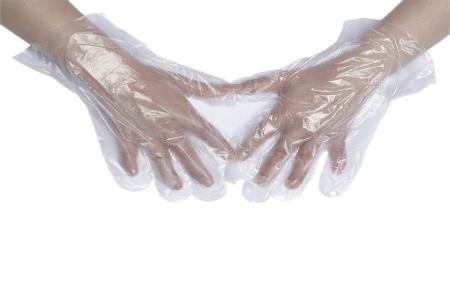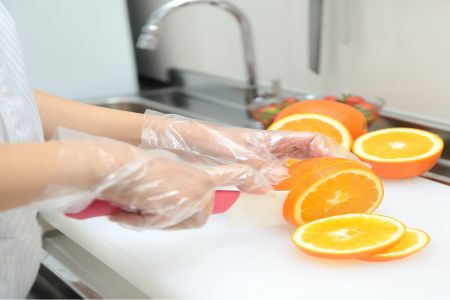Everything You Need to Know about Polyethylene Gloves
Published on 2022/8/16

Share to:
Everything You Need to Know about Polyethylene Gloves
Polyethylene (PE) gloves are used in a variety of industries and applications. They’re used in food manufacturing, pharmaceuticals, textiles, print production and even paint manufacturing.
Polyethylene (PE) gloves are used in a variety of industries and applications. They’re used in food manufacturing, pharmaceuticals, textiles, print production and even paint manufacturing. Polyethylene is a non-woven synthetic material that has excellent tensile strength and high resistance to abrasion, chemicals, oils and solvents. It’s also resistant to oils, acids, alkalis, alcohols and salts. Because of their versatility, PE gloves are used in many different types of industries. Read on for more information about polyethylene gloves: their uses, properties and care tips.
What is Polyethylene?
Polyethylene (PE) is a type of polymer created from ethylene. This is the same chemical that makes up plastic. There are many different grades of PE that are manufactured to meet specific requirements. Polyethylene has excellent tensile strength, and high resistance to abrasion and chemicals, oil and solvents. It’s also resistant to acids, alkalis, alcohols and salts. PE is used in many different industries for various reasons. It’s extremely versatile and can be used in a variety of applications.
Care Tips for Polyethylene Gloves
- Rinse your hands with warm water to clean off dirt and debris.
- Dry your hands with a clean towel or air dry.
- Use baby wipes or a microfleece wipe to wipe your hands clean.
- Store your gloves in an air-tight plastic bag.
- Don’t leave your gloves in the car if possible. Heat and humidity can damage your gloves and make them unusable.
- Don’t wear your gloves when you’re swimming or sweating profusely. This will cause your gloves to become damaged and your hands will become smelly.
- Clean your work area regularly to prevent the build-up of debris. This will keep your hands clean and prevent cuts and abrasions.
How to Choose the Right Pair of PE Gloves
As with all types of gloves, it’s important to choose the right pair for your needs. There are many factors to consider when choosing a pair of polyethylene gloves.
- Thickness - Polyethylene gloves can come in a variety of thicknesses. Thinner gloves are thinner than latex gloves, while thicker gloves are thicker than latex.
- Fit - Polyethylene gloves should fit snugly, but not be too tight. If they’re too tight, you won’t be able to wear your other clothing items. If they’re too loose, they’ll flap around as you walk or they’ll fall off.
- Durability - PE gloves should have a durable outer layer. They should also be able to withstand certain types of wear and tear. Look for gloves that are puncture resistant, tear resistant and have resistance to oil, acids and alkalis.
- Cost - PE gloves come in a variety of prices, depending on the manufacturer and quality of the gloves. You should be able to find a pair of polyethylene gloves that fit your budget.
- Polyethylene Gloves vs Latex Gloves. The main difference between polyethylene gloves and latex gloves is the polymer. Polymer is a natural outgrowth of bacteria that uses ethylene as a source of energy. Polymer provides many benefits over latex, including increased strength and durability, and resistance to chemicals and oil.
Different Types of Polyethylene Gloves
- Contact. Polyethylene is excellent for handling food products, pharmaceuticals and chemicals. It’s not suitable for handling chemicals or food products where gluten is present.
- Cut. Polyethylene is resistant to cutting. It’s suitable for carpentry, painting and construction. It’s not suitable for delicate fabrics like silks or knits.
- Dish. Polyethylene is resistant to oil, grease and fats. It’s also resistant to acids and alkalis. It’s not suitable for delicate items, like porcelain or glass.
- Medical. PE gloves for medical use are designed to reduce chemical exposure and be more comfortable for patients. They also have increased durability.
Which Type of Polyethylene Should You Use?
PE could be considered a hybrid polymer. It has properties of a natural polymer like latex but can withstand certain types of wear and tear like nylon. Because of this, it’s often used in construction, carpentry and painting. It’s also used in applications like food handling and medical devices. PE is excellent for a variety of applications but could be more durable than you need depending on the application. It’s also not as durable as most types of nylon.
Conclusion
Polyethylene has excellent tensile strength, and high resistance to abrasion and chemicals, oil and solvents. It’s also resistant to acids, alkalis, alcohols and salts. The most common type of PE used in the manufacturing industry is contact PE. It’s used in food handling and is a natural-looking polymer. PE gloves come in a variety of different types and are versatile for a variety of applications. The most important thing to keep in mind when choosing a pair of gloves is your hands. Their size, shape and length of fingers should be considered when selecting a pair of gloves.



 WhatsApp
WhatsApp
Send us your message
You can send an email asking for the price and detailed information of this product. We will reply you as soon as we receive your email